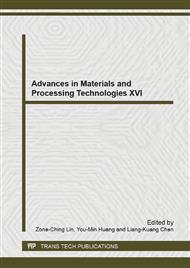p.209
p.214
p.222
p.230
p.239
p.245
p.253
p.260
p.266
Effect of Punch Surface Topography on Friction in Micro Combined Forward and Backward Extrusion of Brass
Abstract:
Friction is one of the key factors affecting the metal forming process. If the friction effects of the process can be accurately modeled, it is able to improve simulations and help the research and development of the metal forming process. This study used cylindrical brass (JIS C2600) billets with the height and diameter of 1.1 mm for conducting the experiments of the micro combined forward and backward extrusion. The purpose of the study was to investigate the effects of punch surface topography on friction in the process. Four surface topography conditions for 0.8 mm diameter punches were prepared by grinding, polishing, grooving and micro electrical discharge machining processes. By comparing the ratio of the cup height to rod length of the extruded cups with the calibration curves established by simulations, the friction factor was estimated in a range from 0.3 to 0.6. The results showed that the punch surface topography significantly affect the friction in the extrusion process. The predicted loads using the estimated friction factors were in good agreement with the experimental results.
Info:
Periodical:
Pages:
239-244
Citation:
Online since:
May 2014
Authors:
Keywords:
Price:
Сopyright:
© 2014 Trans Tech Publications Ltd. All Rights Reserved
Share:
Citation:


